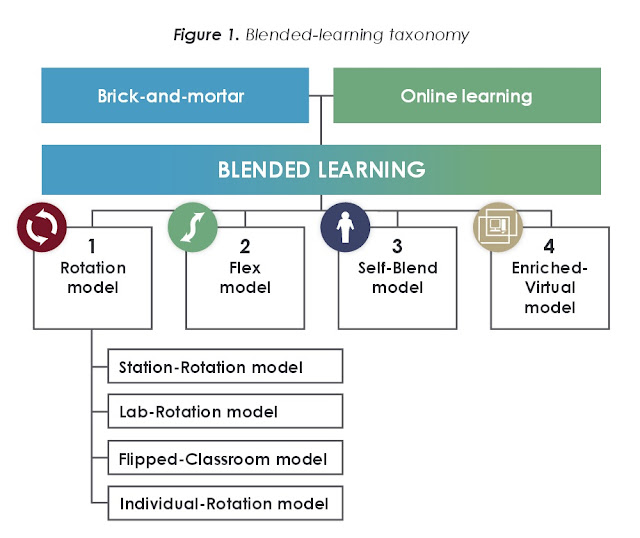What is Blended Learning?
Based upon the research I've done into Blended Learning, the definition I have found the most common for this learning model is found on the Khan Academy website. The definition itself was provided by the Clayton Christensen Institute. According to the CCI, Blended Learning is a "formal education program in which a student learns at least in part through online learning, with at least some control over time, place, path, and/or place; at least in part in a supervised brick-and-mortar location away from home; and the modalities along each student's learning path within a course or subject are connected to provide an integrated learning experience."
Based upon the research I've done into Blended Learning, the definition I have found the most common for this learning model is found on the Khan Academy website. The definition itself was provided by the Clayton Christensen Institute. According to the CCI, Blended Learning is a "formal education program in which a student learns at least in part through online learning, with at least some control over time, place, path, and/or place; at least in part in a supervised brick-and-mortar location away from home; and the modalities along each student's learning path within a course or subject are connected to provide an integrated learning experience."
Most blended learning programs also usually utilize one of four models: Rotation, Flex, A La Carte, and Enriched Virtual. The Rotation Model also includes four types: Station-Rotation, Lab Rotation, Flipped Classroom, and Individual Rotation. No matter the model, the emphasis in blended learning is on engaging students, and creating more personalized and meaningful instruction to meet each student's individual needs, in effort to increase and accelerate student learning.
 |
| From the Clatyon Christensen Institute |
Authors on the Mindflash website also suggest that there is "no single, reliable definition of blended learning," and that it is also referred to as "hybrid, mixed, or integrative" learning. They also note that blended learning has "inspired educators to redefine traditional roles," with the word, "facilitator" becoming more commonly used in blended learning environments. The facilitators place a strong emphasis on "empowering students" with the skills and knowledge they need to effectively work online and independently, so that they can have a more meaningful learning experience.
The following video provides a quick and interesting overview of what a blended learning environment looks like in a K-12 classroom.
What is Blended Learning? from The Learning Accelerator on Vimeo.
Not only can blended learning benefit students by resulting in increased and accelerated student learning, it can have other benefits as well. According to Debbie Morrison, in her article, Is Blended Learning the Best of Both Worlds (2013), blended learning can help students build digital citizenship skills, "information management skills, self-directed learning, and web research and collaboration skills" as well.
To summarize, a blended learning environment utilizes both face-to-face and online instruction, and allows students at least some control over time, place, path, and/or place. The focus of blended learning is on engaging students, creating more personalized and individualized instruction, in order to increase and accelerate student learning. Blended learning also redefines teacher roles as that of facilitators, and can help students build other meaningful skills along the way.
My Google Doc of research notes on Blended learning can be found here:
https://docs.google.com/a/findlay.edu/document/d/1CfgIIIfrtA2I1AJvBtjxiLLs5migpgV51bMX_GD8LPA/edit?usp=sharing
My Google Doc of research notes on Blended learning can be found here:
https://docs.google.com/a/findlay.edu/document/d/1CfgIIIfrtA2I1AJvBtjxiLLs5migpgV51bMX_GD8LPA/edit?usp=sharing
Yes! The possibilities for teaching online courses just keep growing.
ReplyDelete